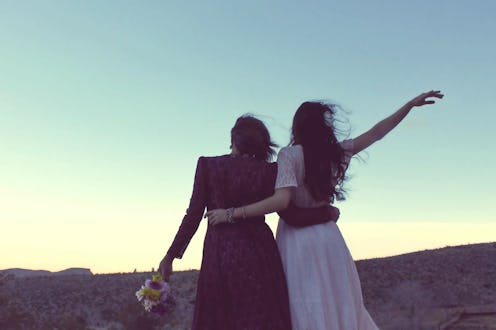Life
This Dating Company Knows What Millennials Want

When John Kershaw launched his beard-focused dating app, Bristlr, in 2014, he let his users identify in one of two ways: those with beards and those without beards. What was noticeably absent from the sign up process, however, was any kind of gender identifier. No toggle or check for “male” or “female” — just "bearded" or "not bearded." And that choice to stay away from the gender binary, Kershaw says, was a conscious one.
“If you’re going to split people down a binary, you better pick an important one,” Kershaw tells Bustle. “So I thought whether you’re follicly-gifted would be the answer.”
Follicly-gifted or follicly-challenged may have worked fine for Bristlr — whose tagline is “connecting those with beards to those who want to stroke beards” — but when Kershaw spun the unexpected success of his beard-o dating app into M14 Industries, a company that provides the resources for anyone who wants to make their own dating app, he realized that he couldn’t keep avoiding the issue of gender. But he wasn’t comfortable doing what most dating apps do, which is default to the binary: toggle for male or female. When he dived into figuring out how to solve the problem of non-binary gender on dating apps and sites, however, he quickly realized that there wasn’t a lot of information out there for people who want to be more gender inclusive.
Which is kind of bonkers, right? According to the Massive Millennial Poll conducted for Fusion — which was released last year and included 1,000 people between the ages of 18-34 — 50 percent of Millennials don’t think that there are only two genders. Instead, more and more people are coming to understand gender as something that — like sexuality — exists on a spectrum. More and more of us are coming to accept that genitals don’t necessarily determine someone’s gender and that some people simply don’t identify as male or female at all.
Kershaw’s initial solution to this problem is to keep the old male/female option but also include a text box where people can write in their own gender. But including that text box is just the first step.
According to the Pew Research Center, 27 percent of 18- to 24-year-olds and 22 percent of 25- to 34-year olds used an online dating app or website in 2015 and use for 18- to 24-year-olds increased threefold from 2013 to 2015. That means that almost a third of that same age group that increasingly doesn’t think gender is a binary is using or has used online dating. And if the trends continue as they have, both of those percentages are only going to rise.
The problem is that it’s very easy to match people who identify as female, for example, with one or both genders they’re attracted to. What’s not so easy is matching people who identify as a range of genders — some of which might be completely of their own making — with other people who identify with a range of genders.
Kershaw’s initial solution to this problem is to keep the old male/female option but also include a text box where people can write in their own gender. But including that text box is just the first step. His long-term solution to helping everyone be more gender inclusive is The Open Gender Project, where currently anyone can call and ask for free advice and, in the future, people will be able to find searchable resources on gender inclusivity. And while their initial focus is obviously dating apps, he says that anyone with a question about gender diversity — from people trying to figure out how many sit-down or stand-up toilets they need for a festival to people who want to be non-discriminatory on their job application forms — can call.
The Open Gender Project isn’t the first group — and won’t be the last — to tackle the issue of gender diversity. Kershaw doesn’t even expect that they’ll be the best at solving this issue, but he’s committed to listening to gender non-conforming people talk about their own experiences and incorporating their feedback into what The Open Gender Project does. And that, my friends, is how progress is made.
Images: Giphy (3); BhaktiCreative/Pixabay